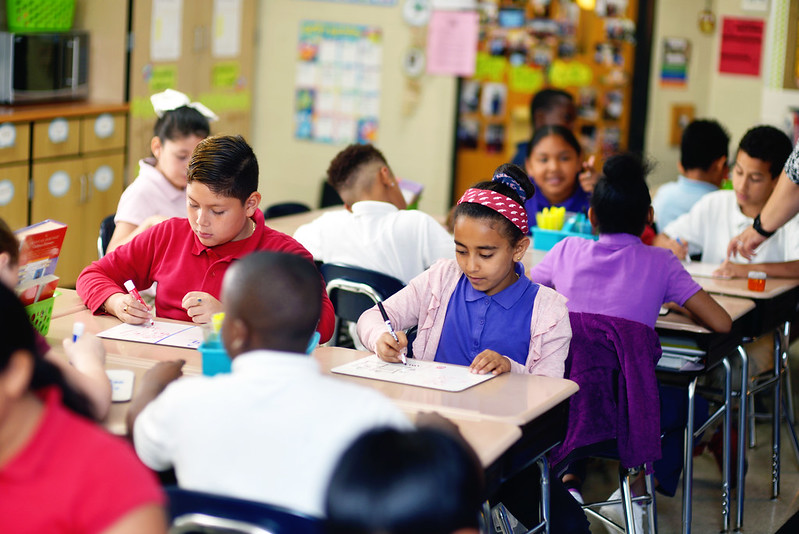
The Nation’s Report Card is in, offering one of the first national snapshots of student academic outcomes since the COVID-19 pandemic began. The results confirm what we’ve seen in our own state assessment — that Tennessee has experienced a decline in student learning over the last few years. These results, along with the Tennessee Comprehensive Assessment Program (TCAP) assessment results, show that we must focus our efforts on strategies that support learning recovery for all students, and many of these strategies are already being implemented in the Volunteer State.
Why NAEP Matters
The National Assessment of Educational Progress (NAEP), also known as the Nation’s Report Card, is a critical benchmark of student progress in fourth- and eighth-grade reading and math. NAEP allows us to measure our progress over time as well as to compare how we are doing to the rest of the nation and our neighboring states. It is one of our most important measures of student achievement, serving as a critical benchmark for Tennessee’s progress in education over the last 15 years. Together with TCAP, NAEP data provide educators, families, and policymakers with valuable information that allows for data-informed policy decisions and targeted investments — and the ability to better understand where we are and which students need the most support in the months and years to come.
The 2022 NAEP showed us that the pandemic’s impact on student learning across Tennessee is significant and consistent with national declines. While the data show that Tennessee’s students were impacted similarly to the rest of the nation, students from low-income backgrounds and students of color were disproportionately impacted by the pandemic’s impact on learning.
Tennessee’s Performance Closely Mirrors National Trends
The performance of Tennessee students in 2022 remains closely aligned with the national average, with proficiency rates within 1 to 2 percentage points of the national average. For most areas, proficiency has dropped to its lowest level on NAEP since 2011, with less than one in three students proficient overall. The chart below shows that the performance of Tennessee students matches the academic outcomes seen nearly a decade ago. Concerningly, eighth graders now stand where they did in 2009 across both reading and math. This presents significant readiness concerns as students transition into high school and look ahead to postsecondary education and the workforce.
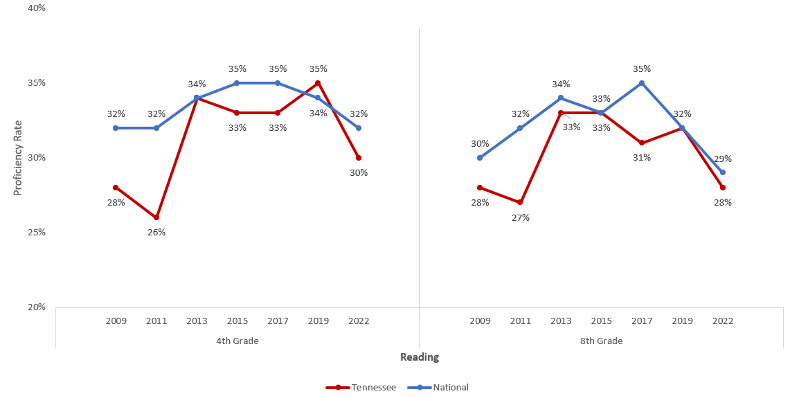
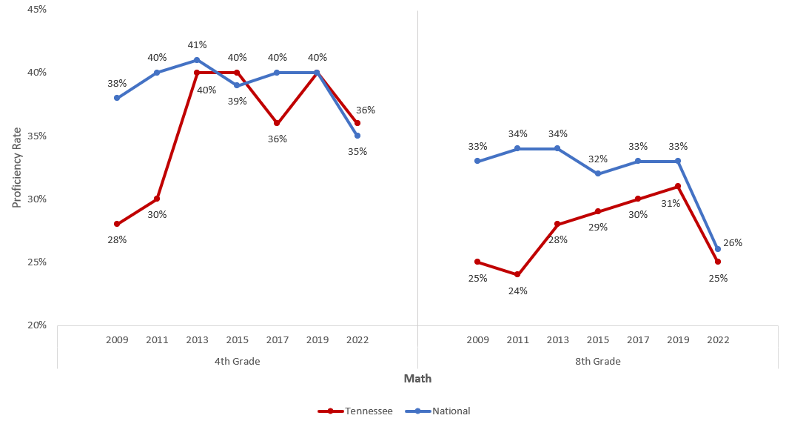
Hispanic Students Make Up Ground, Though Gaps Persist For Students Of Color Overall
In fourth grade, Hispanic students offer a bright spot. Across both reading and math, Hispanic students made up ground that was lost in 2019, seeing improvements in both fourth-grade math and reading. Significant achievement gaps still persist between student groups, with a Black-White student performance gap of more than 20 percentage points and a Hispanic-White student performance gap of 15 percentage points. Perhaps most concerningly, the Black-White achievement gap widened in the last year. White students are three times more likely to be proficient in reading and four times more likely to be proficient in math compared to Black students.
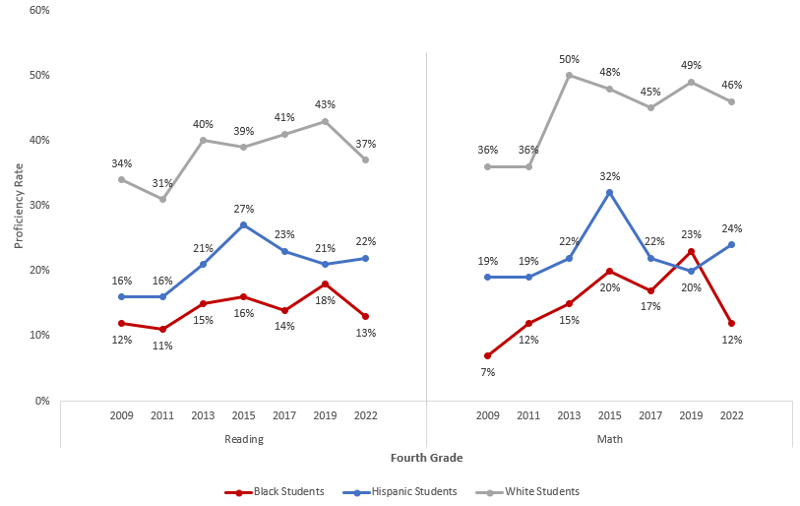
Prepandemic Trend Continues To Widen Gap For Struggling Students
Both fourth- and eighth-grade students show a widening gap between highest and lowest performers, consistent with a prepandemic trend that higher achieving students are driving gains for the state while those who are struggling are falling further behind. While ceiling scores stayed relatively flat amid pandemic declines, the floor continues to fall. This trend is also reflected in state assessment data for reading, which is marked by an increase in students scoring in the lowest performance category. This data clearly demonstrates that students who were already struggling academically prior to the pandemic were hit the hardest by learning disruptions and will need the most support to catch up to their peers moving forward.
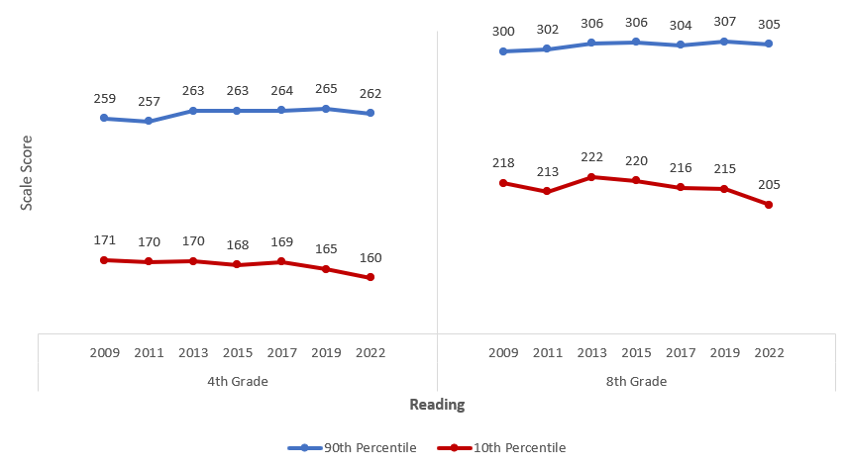 NAEP grades 4 and 8 scale scores for reading by performance percentile from 2009 to 2022 (NAEP, 2022)
NAEP grades 4 and 8 scale scores for reading by performance percentile from 2009 to 2022 (NAEP, 2022)Tennessee Must Recommit To Effective And Research-Based Recovery Strategies
Armed with the valuable insights and focus these results provide, Tennessee must recommit itself to the effective implementation of recovery strategies that are known to work, such as a comprehensive approach to early literacy, implementing high-dosage tutoring, and strengthening data collection and reporting.
- High-Dosage Tutoring
This research-based practice can help schools and districts close student learning gaps and accelerate learning, and Tennessee has prioritized this work as both a recovery strategy and a sustainable support strategy. Tutoring works best when it occurs in small groups at least three times a week during the school day using high-quality instructional materials with a highly effective educator. In SCORE’s analysis of state Elementary and Secondary School Emergency Relief Fund (ESSER) plans, we saw that three-fourths of Tennessee school districts are investing in tutoring, but not all of these programs are aligned to high-dosage low-ratio tutoring best practices. To expand this effective instructional intervention, Tennessee should strengthen data collection and reporting on high-dosage tutoring in order to learn better how students are identified and supported for learning acceleration prior to third grade, and all districts should commit to implementing this work in a way that aligns to best practices. - Improving Early Literacy
Policies like the Tennessee Literacy Success Act support systematic phonics instruction in the early grades, the use of strong ELA curriculum to build background knowledge, and improved educator preparation and professional development for effective literacy instruction. Moving forward, Tennessee should prioritize clear intervention strategies for students identified as having a significant reading deficiency in K-2 and adopt a literacy assessment for new educators entering the classroom. These steps will ensure that students continue to recover and accelerate learning in reading. - Strengthen Data Collection And Reporting
To better understand the path to recovery, teachers, school and district leaders, policymakers, and communities need information about how students are being served by our intervention and acceleration strategies. The state should collect and share data about the number of students served through RTI2, tutoring, and summer learning camps, as well as information about whether those supports are moving students toward proficiency. Robust and transparent systems for progress monitoring will help ensure quality implementation.
These are the right interventions for supporting students, and we must ensure we are implementing these strategies with quality — particularly for the students who need the greatest support — while continuing to explore additional interventions to help all students get back on track.
We are in the first quarter of our efforts to recover from the effects of the pandemic. Tennessee has the right playbook. Now we must execute on what research shows is most likely to improve student learning.
David Mansouri is SCORE’s president and CEO.
